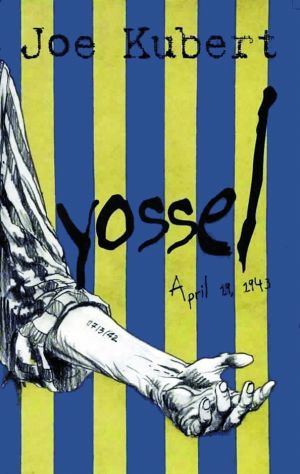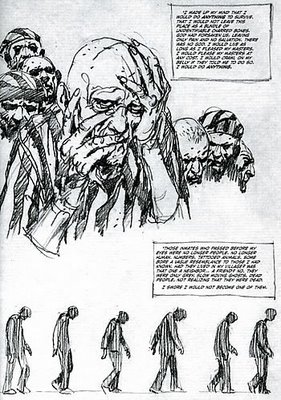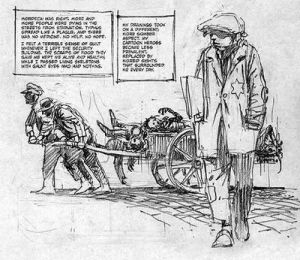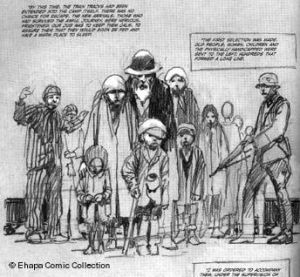Comics /
Spotlight /
Progressive Panels
Joe Kubert’s Yossel: April 19, 1943
By Andy Frisk
May 15, 2011 - 22:51
To many admirers, critical reviewers, and individuals working in the sequential art field, Joe Kubert is a living legend. Over the course of his 60 year career in sequential art, Kubert has illustrated almost every popular superhero and war story comic book character. Perhaps best know for his work on DC Comics titles such as Our Army at War and Sgt. Rock, Kubert and war comics are two distinct entities that are oft mentioned in the same breath with praise. Kubert’s art and storytelling talents have inspired many sequential artists and cartoonists over the years, and his school, The Joe Kubert School of Cartoon and Graphic Art, is the only accredited school in existence solely devoted to the subject. Joe Kubert’s life story is quintessentially American. The son of Jewish immigrants who managed to leave Poland just over a decade before the Nazi jackboot of Hitler’s army crushed the spirit and stole the lives of countless Jewish citizens of Poland, Kubert managed to live the American dream. He was able to pursue his love of drawing and managed to make a very successful career and life out of doing what he loved. Things could have turned out very differently for Kubert though. If his parents didn’t manage to successfully immigrate to America when they did, Kubert could have lived a very different and painfully short life as a member of a Nazi concentration camp, or as a resident of the Warsaw Ghetto that was established by the Nazis for the so called “protection” of Poland’s largest city’s Jewish population. In reality, the Warsaw Ghetto was just a stopping point for Poland’s Jews on the way to their final resting places as determined by Hitler’s “Final Solution.” Kubert was spared from the definitively evil machinations of the Nazi’s Third Reich, but he was acutely aware of what was happening in his homeland. Kubert’s parents, through their contacts and friends still in Poland and Europe who were survivors of the Nazi horrors, were uniquely informed on a first hand basis of events. Kubert, as he notes in his introduction to this new printing of Yossel: April 19th 1943, states that it was through the preserved letters and correspondences of his parents with friends and family in Poland and through “the things I read and historical data” that he was able to write this alternate reality, yet historically based, quasi-autobiography. Kubert becomes the young boy named Yossel. It is fitting that Kubert uses another name, as he would have effectually been a different person if his family had never left Poland. Yossel April 19, 1943 is the story of the life Kubert could have lived, and the lives that many millions of Jews did live during the Second World War. It is more than just another heart-wrenching Holocaust story. It is the heartfelt story of a boy that never was, yet very well could have been. It is also unique amongst graphic novel and other sequential art works in it’s illustration of this horrific period of human history.
 |
Kubert decided to tell this story in a very raw and visceral way by eschewing many sequential art conventions while retaining, at the work’s core, the very characteristics that makes sequential art the unique storytelling medium that it is. Kubert decided to use his uncolored and unfinished pencil sketches, printed upon gun metal gray smudged paper, to tell his story. The lack of color, excluding the gun metal gray and the black and white of the sketches, drenches the whole work in a sort of devouring gloom fitting of the subject matter. All the work’s sketches can be considered unfinished in a strictly sequential art/comic book sense, but some of them are less flushed out than others. One might think that the unfinished and colorless nature of Kubert’s drawings might be a drawback, especially considering that
Yossel: April 19, 1943 is graphic novel, but the exact opposite is true. This is not just due to the fact that Kubert is a talented artist who can bring to life and convey the emotions of the story’s characters masterfully, even with an unfinished sketch. Kubert’s varying degrees of polish and completeness conveys not only the aforementioned emotional weight, but other interesting aspects of the story. The perception of time, conscious recognition of time and events, and character point of view are all presented in new and interesting ways. Kubert makes unique use of the varying completeness of his sketches to dramatic effect. For example, during the scene where Yossel’s family is being evicted from their home, which also houses their kosher butcher shop (the family’s source of income), Kubert’s sketches become more and more undefined and thinly detailed as he illustrates the incident’s events. The incident starts with Yossel falling asleep at his drawing table. It progresses to the Nazis arrival at their front door, and finally on to the family’s hurried packing of what scant belongings they can carry in their horse drawn cart to the Warsaw Ghetto. The deterioration of the detail of the sketches helps to visually convey the sense of the hurriedness and strangeness of the events to Yossel’s eyes. Also, if one considers the drawings as images that Yossel is sketching in his mind as he lives through the harrowing and horrific events of the time, then the lack of detail in his memories of these events also convey the speed at which they happened. One remembers events that repeat in one’s life or events that unfold over a longer period of time in a much more detailed manner than hurried events. Kubert also employs his unique use of varying detail in his sketches to relate mass images that blend into one another, such as the collection of eye glasses and shoes that the Nazis pile up outside the gas chambers, and horrifically experienced and specifically remembered events, of the type the escaped Rabbi relates to Yossel and his gang of burgeoning resistance fighters in the Warsaw Ghetto. Mass images like a pile of glasses would blend into a sparsely detailed mental image, but the scene of a gas chamber loaded with dead bodies that the Rabbi was forced to clean out would sear itself into the mind’s eye and be remembered in much more realistic detail.
 |
Kubert uses the unconventional technique of telling a sequential art story through unfinished sketches of varying detail to transcend the story’s written narrative, which is presented from of Yossel’s first person perspective, and to add a subtly heightened sense of the unnatural nature of the events in the Warsaw Ghetto and the Nazi camps. Yossel visually appearing in the work is unconventional in the sense of the story being a first person narrative. Sequential art though, like film, is unique in its capacity to be written (or heard in film’s case) in the first person, but actually show the image of the “I” (or first person narrator) of the work from the third person perspective. Yossel at times appears very vividly in the depicted events, but at other times is nearly absent from the images. He appears in varying detail as well, as if Yossel is seeing himself through his mind's eye at times and through the eyes of his loving family and loyal friends at others. At multiple times during the story, Yossel relates how he just “has to” draw the images he sees around him instead of the fantasy and superhero worlds he uses to escape his current situation through, so his appearance in the sketches might just be reflective of the sketches he is doing during this period of his life. These sketches though would never have been found by anyone since the Warsaw Ghetto was pretty much destroyed during the uprising. So the question becomes: are these drawings supposed to be the actual drawings done by Yossel or Kubert as Yossel’s creator metaphorically? Obviously, in reality they are Kubert’s, but Kubert very vividly allows for the work’s sketches to appear as unfinished drawings. The nature of the art in
Yossel: April 19, 1943 draws attention to itself as a work of art just as a film director purposefully leaving boom mikes or video tracking numbers visible in a film would purposefully draw the audience’s attention to what they are viewing is a film (being made by someone). The unfinished nature of the sketches draws attention to the fact that this is a story being told by a real person (either Yossel as a character being the “real” person or Kubert), therefore yielding credence to the fact that even though this is a fictional story it is based on real events, much like a fictional image must be drawn (or filmed) by a real person.
 |
Also, Kubert wants his audience to see the sketching and shadowing that goes into creating, and exists behind, the finished drawn image. He is metaphorically exposing the skeleton of the art visually much in the same way that the skeletons of the abused concentration camp survivors were exposed. It is not natural for a work of sequential art to retain this unfinished and exposed type of look. It is not natural, in fact inhuman when intentionally caused, for a living human’s skeleton to be so easily visible through starvation tightened skin, just as the events perpetrated by the Nazis were unnatural and inhuman.
Yossel: April 19, 1943 is not a natural work of fantasy, even though it is an alternate reality work of fiction based upon true events. Kubert wants his readers to see his unfinished sketches, and therefore the sketches’ “skeletons” in order to communicate metaphorically, and in a uniquely artistic way, the point that this is the story of incredibly unnatural and inhuman events. Images of a first person narrated story’s protagonist envisioned doubly and unnaturally through the author and the character’s minds’ eyes, the exposed “skeleton’s” of the artwork, and the varying finished and unfinished nature of the artwork combines to create an unnaturally unsettling overall image and emotional aspect to the work, just as the evil done by the Nazis was unnatural, and evil.
Putting aside all of the esoteric musings as to the ideas behind Kubert’s choice to leave the artwork unfinished in
Yossel: April 19, 1943, this work will elicit the same emotional reaction from the reader whether or not they even are aware of the meaning behind the artistic choice to leave the artwork unfinished. One must be inhuman not to find any story that is set during the Holocaust unmoving.
Yossel: April 19, 1943, much like the film
Schindler’s List and the graphic novel
Maus, is emotionally draining, angering, and inspiring at the same time.
Yossel: April 19, 1943 will bring tears to your eyes, while inspiring you to be on the lookout for the next inhuman, bigoted, and racist movement that bears the same inhuman characteristics of Nazism. It will also reaffirm that the human spirit, even in the face of insurmountable evil, remains resilient. Works that deal with the Holocaust are incredibly difficult to watch, read, or immerse oneself in. They must be experienced though, if only to ensure that this type of history doesn’t repeat itself.
Yossel: April 19, 1943 should be required reading for everyone.
Rating: 10 /10
Last Updated: January 17, 2025 - 08:20



